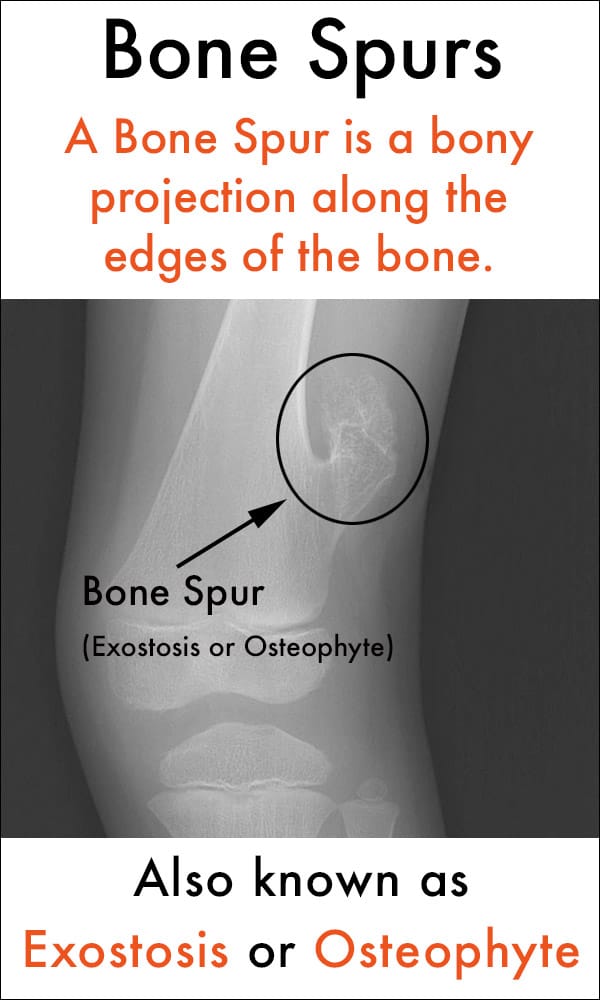What is a Bone Spur (Exostosis)?
A Bone Spur is a bony projection that can develop along the edges of the bone, and it goes by the medical term, “Exostosis.”
Also known as “Osteophytes,” bone spurs typically form in the joints, where bones are connected and rubbing against one another. This bit of extra bone can form in almost any place in the body adjacent to the bones:
Common areas where bone spurs occur include the following:
- Neck Spurs
- Spine Spurs
- Shoulder Spurs
- Heel Spurs
- and of course, bone spurs in the foot
Though they are usually smooth formations, a bone spur can cause irritation and pain, as well as wear and tear, when they continually come into contact with soft tissues, like tendons or ligaments.
What Causes Bone Spurs?
Bone spurs can be caused by a number of different issues. Here are some of the most common causes:
1. Friction or Pressure
Pressure, friction or stress on a particular part of the body over an extended period of time can cause spurs on the bone to form.
2. Repetition
Repetitive movements associated with physical activity, such as jogging, pitching, tennis or other sports related activities can also cause spurs.
3. Age
Age is another common reason for Exostosis to occur. Cartilage, the tissue that cushions the end of bone inside the joints, breaks down during the aging process. As it continues to wear away, a person can develop osteoarthritis. This is also a factor in the discs of the spine.
The added friction, due to a lack of cartilage, can lead to pain and inflammation, as well as cause bone spurs to form at the edges of the joints. Ultimately, the affected area is the body’s attempt to heal itself by creating more bone.
Other Reasons People Develop Bone Spurs Can Include:
- Chronic pressure on the joints as a result of being overweight
- Tight ligaments due to physical activities, like dancing or running that stress the foot and heel
- Poorly fitting or overly tight shoes
- Continued pressure on the heel from footwear like high-heels can cause heel spurs
The shoulder joint is another common area where bone spurs develop, especially in athletes and people who do activities where their hands are frequently held over their head.
With overuse, repetitive motion, and age, spurs on the bone can develop because of the repeated friction between the tendon and bones in the shoulder.

What Are Common or Typical Bone Spur Symptoms of Exostosis?
Most of the time, people never realize that they have bone spurs because they don’t always cause pain or irritation.
Bone spurs can be seen on an X-ray, though they are usually discovered in patients receiving an X-ray for other issues, such as arthritis or a soft tissue injury of some sort.
Sometimes, however, bone spurs repeatedly come into contact with other tissue or bone, or cause friction in surrounding muscles and tendons. When this happens, they can wear that tissue down and lead to inflammation, tears, and persistent pain.
Other Bone Spur Symptoms May Include Any of the Following:
- Decreased range of motion in afflicted joints
- Numbness, weakness or tingling in the arms or legs if a spur is coming into contact with a nerve, or nerves in the spine
- Calluses or corns in the foot where tissue develops to provide extra padding over a bone spur
- Bumps in the skin where spurs are located, usually in the hands or fingers
- Joint pain and stiffness
Do Bone Spurs go Away on Their Own?
Many people wonder if bone spurs go away on their own, and unfortunately they do not. Generally, this is not a problem, as most of the time they do not cause painful symptoms.
However, when a bone spur causes damage to the surrounding tissue or chronic pain, there a number of steps people can take to get relief from the discomfort and irritation.
Working with a physical therapist, learning stretching techniques, and even getting deep tissue massages in the affected area can lead to relief. Weight loss, if necessary, can help relieve excessive pressure on joints with bone spurs.
In serious cases, where a bone spur is creating severe pain, damaged tissue or any deformities in the area, they may need to be be surgically removed.
Other Therapies for Bone Spurs Can Include:
- Different or better fitting shoes and footwear
- Padding of calluses or corns that have grown over bone spurs
- Taking over the counter, non-steroidal, anti-inflammatory painkillers like ibuprofen in the form of Advil or Motrin
- Heel cups, padded insoles, or specially-fitted orthotics in shoes
- Icing inflamed areas and resting can reduce swelling and bring relief as well
Bone Spur Treatment For Exostosis
An effective bone spur treatment is EPAT Therapy, a non-invasive method for increasing the speed of healing and limiting bone spur-related downtime.
EPAT Therapy is also known as Extracorporeal Shock Wave Therapy (ESWT) and it is quickly becoming a popular method of treating a wide number of sports-related injuries.
This painless, regenerative treatment helps injured muscles and tendons heal faster by delivering impulse pressure waves deep within damaged soft tissue.
With each session, deep muscle stimulation increases blood flow to irritated tendons and ligaments and reduces inflammation.
Because EPAT Therapy is non-surgical, there is no anesthesia necessary, no scarring, and no risk of infection.
In some cases, athletes or workers can actually undergo treatment sessions for bone spurs or exostosis while still maintaining high levels of performance and continuing their normal routine.